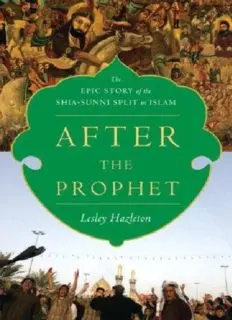
After the Prophet: The Epic Story of the Shia-Sunni Split in Islam PDF
Preview After the Prophet: The Epic Story of the Shia-Sunni Split in Islam
ALSO BY LESLEY HAZLETON Jezebel: The Untold Story of the Bible’s Harlot Queen Mary: A Flesh-and-Blood Biography of the Virgin Mother Jerusalem, Jerusalem: A Memoir of War and Peace, Passion and Politics Where Mountains Roar: A Personal Report from the Sinai Desert Israeli Women: The Reality Behind the Myths Contents Note on Usage and Spelling Map: The Middle East in the Late Seventh Century P ROLOGUE P O ART NE M UHAMMAD P T ART WO A LI P T ART HREE H USSEIN Acknowledgments Notes Sources Note on Usage and Spelling Throughout this book, I have used (cid:633)rst names for major (cid:633)gures rather than full names, in order to avoid the “Russian novel e(cid:643)ect,” where English readers su(cid:643)er the confusion of multiple unfamiliar names. Thus, for instance, I have used Ali instead of Ali ibn Abu Talib, Aisha instead of Aisha bint Abu Bakr, Omar instead of Omar ibn al-Khattab, and so on. I have used fuller names only where there is a risk of confusion; thus, the son of the (cid:633)rst Caliph, Abu Bakr, is referred to as Muhammad Abu Bakr, itself abbreviated from Muhammad ibn Abu Bakr. I have used the spelling “Quran” instead of the more familiar English rendering “Koran” for the sake of both accuracy and consistency, and in order to respect the di(cid:643)erence between the Arabic letters qaf and kaf. Otherwise, wherever possible, I have used more familiar English spellings for the names of major (cid:633)gures (Othman, for instance, instead of Uthman or Uttman, and Omar instead of Umar) and have purposely omitted diacritical marks, using Shia rather than Shi’a, Ibn Saad instead of Ibn Sa’d, Muawiya instead of Mu’awiya, Quran instead of Qur’an. Prologue T . I after the blast, the HE SHOCK WAVE WAS DEAFENING N THE FIRST FEW SECONDS millions of pilgrims were rooted to the spot. Everyone knew what had happened, yet none seemed able to acknowledge it, as though it were too much for the mind to process. And then as their ears began to recover, the screaming began. They ran, panicked, out of the square and into the alleys leading to the gold-domed mosque. Ran from the smoke and the debris, from the blood and shattered glass, the severed limbs and battered bodies. They sought security in small, enclosed spaces, a security obliterated by the next blast, and then the next, and the next. There were nine explosions in all, thirty minutes of car bombs, suicide bombs, grenades, and mortar (cid:633)re. Then there was just the terrible stench of burned (cid:635)esh and singed dust, and the shrieking of ambulance sirens. It was midmorning on March 4, 2004—the tenth of Muharram in the Muslim calendar, the day known as Ashura. The city of Karbala was packed with Shia pilgrims, many of whom had journeyed on foot the (cid:633)fty miles from Baghdad. They carried huge banners billowing above their heads as they chanted and beat their chests in ritualized mourning for the Prince of Martyrs, Muhammad’s grandson Hussein, who was killed in this very place. Yet there was an air of celebration too. The mass pilgrimage had been banned for years; this was the (cid:633)rst time since the fall of the Saddam regime that they had been able to mourn proudly and openly, and their mourning was an expression of newfound freedom. But now, in a horrible reverse mirror of the past, they too had been transformed into martyrs. The Ashura Massacre, they would call it—the (cid:633)rst major sign of the civil war to come. And on everyone’s lips, the question, How had it come to this? The Sunni extremist group Al Qaida in Iraq had calculated the attack with particularly cruel precision. When and where it took place were as shocking as the many hundreds of dead and wounded. Ashura is the most solemn date in the Shia calendar—the equivalent of Yom Kippur or Easter Sunday—and the name of Karbala speaks of what happened on this day, in this place, in the year 680. It is a combination of two words in Arabic: karab, meaning destruction or devastation, and bala, meaning tribulation or distress. Muhammad had been dead not (cid:633)fty years when his closest male descendants were massacred here and the women of his family taken captive and chained. As word of the massacre spread, the whole of the Muslim world at the time, from the borders of India in the east to Algeria in the west, was in shock, and the question they asked then was the same one that would be asked fourteen centuries later: How had it come to this? What happened at Karbala in the seventh century is the foundation story of the Sunni-Shia split. Told in vivid and intimate detail in the earliest Islamic histories, it is known to all Sunnis throughout the Middle East and all but engraved on the heart of every Shia. It has not just endured but gathered emotive force to become an ever-widening spiral in which past and present, faith and politics, personal identity and national redemption are inextricably intertwined. “Every day is Ashura,” the Shia say, “and every place is Karbala.” And on March 4, 2004, the message was reiterated with terrifying literalness. The Karbala story is indeed one without end, still unfolding throughout the Muslim world, and most bloodily of all in Iraq, the cradle of Shia Islam. This is how it happened, and why it is still happening.
